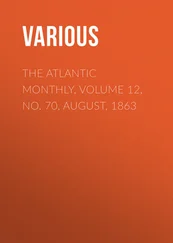Various - The Atlantic Monthly, Volume 10, No. 62, December, 1862
Здесь есть возможность читать онлайн «Various - The Atlantic Monthly, Volume 10, No. 62, December, 1862» — ознакомительный отрывок электронной книги совершенно бесплатно, а после прочтения отрывка купить полную версию. В некоторых случаях можно слушать аудио, скачать через торрент в формате fb2 и присутствует краткое содержание. Жанр: foreign_antique, periodic, foreign_edu, на английском языке. Описание произведения, (предисловие) а так же отзывы посетителей доступны на портале библиотеки ЛибКат.
- Название:The Atlantic Monthly, Volume 10, No. 62, December, 1862
- Автор:
- Жанр:
- Год:неизвестен
- ISBN:нет данных
- Рейтинг книги:4 / 5. Голосов: 1
-
Избранное:Добавить в избранное
- Отзывы:
-
Ваша оценка:
- 80
- 1
- 2
- 3
- 4
- 5
The Atlantic Monthly, Volume 10, No. 62, December, 1862: краткое содержание, описание и аннотация
Предлагаем к чтению аннотацию, описание, краткое содержание или предисловие (зависит от того, что написал сам автор книги «The Atlantic Monthly, Volume 10, No. 62, December, 1862»). Если вы не нашли необходимую информацию о книге — напишите в комментариях, мы постараемся отыскать её.
The Atlantic Monthly, Volume 10, No. 62, December, 1862 — читать онлайн ознакомительный отрывок
Ниже представлен текст книги, разбитый по страницам. Система сохранения места последней прочитанной страницы, позволяет с удобством читать онлайн бесплатно книгу «The Atlantic Monthly, Volume 10, No. 62, December, 1862», без необходимости каждый раз заново искать на чём Вы остановились. Поставьте закладку, и сможете в любой момент перейти на страницу, на которой закончили чтение.
Интервал:
Закладка:
Various
The Atlantic Monthly, Volume 10, No. 62, December, 1862 / A Magazine of Literature, Art, and Politics
THE PROCESSION OF THE FLOWERS
In Cuba there is a blossoming shrub whose multitudinous crimson flowers are so seductive to the humming-birds that they hover all day around it, buried in its blossoms until petal and wing seem one. At first upright, the gorgeous bells droop downward, and fall unwithered to the ground, and are thence called by the Creoles "Cupid's Tears." Frederika Bremer relates that daily she brought home handfuls of these blossoms to her chamber, and nightly they all disappeared. One morning she looked toward the wall of the apartment, and there, in a long crimson line, the delicate flowers went ascending one by one to the ceiling, and passed from sight. She found that each was borne laboriously onward by a little colorless ant much smaller than itself: the bearer was invisible, but the lovely burdens festooned the wall with beauty.
To a watcher from the sky, the march of the flowers of any zone across the year would seem as beautiful as that West-Indian pageant. These frail creatures, rooted where they stand, a part of the "still life" of Nature, yet share her ceaseless motion. In the most sultry silence of summer noons, the vital current is coursing with desperate speed through the innumerable veins of every leaflet; and the apparent stillness, like the sleeping of a child's top, is in truth the very ecstasy of perfected motion.
Not in the tropics only, but even in England, whence most of our floral associations and traditions come, the march of the flowers is in an endless circle, and, unlike our experience, something is always in bloom. In the Northern United States, it is said, the active growth of most plants is condensed into ten weeks, while in the mother-country the full activity is maintained through sixteen. But even the English winter does not seem to be a winter, in the same sense as ours, appearing more like a chilly and comfortless autumn. There is no month in the year when some special plant does not bloom: the Coltsfoot there opens its fragrant flowers from December to February; the yellow-flowered Hellebore, and its cousin, the sacred Christmas Rose of Glastonbury, extend from January to March; and the Snowdrop and Primrose often come before the first of February. Something may be gained, much lost, by that perennial succession; those links, however slight, must make the floral period continuous to the imagination; while our year gives a pause and an interval to its children, and after exhausted October has effloresced into Witch-Hazel, there is an absolute reserve of blossom, until the Alders wave again.
No symbol could so well represent Nature's first yielding in spring-time as this blossoming of the Alder, this drooping of the tresses of these tender things. Before the frost is gone, and while the newborn season is yet too weak to assert itself by actually uplifting anything, it can at least let fall these blossoms, one by one, till they wave defiance to the winter on a thousand boughs. How patiently they have waited! Men are perplexed with anxieties about their own immortality; but these catkins, which hang, almost full-formed, above the ice all winter, show no such solicitude, but when March wooes them they are ready. Once relaxing, their pollen is so prompt to fall that it sprinkles your hand as you gather them; then, for one day, they are the perfection of grace upon your table, and next day they are weary and emaciated, and their little contribution to the spring is done.
Then many eyes watch for the opening of the May-flower, day by day, and a few for the Hepatica. So marked and fantastic are the local preferences of all our plants, that, with miles of woods and meadows open to their choice, each selects only some few spots for its accustomed abodes, and some one among them all for its very earliest blossoming. There is always some single chosen nook, which you might almost cover with your handkerchief, where each flower seems to bloom earliest, without variation, year by year. I know one such place for Hepatica a mile northeast,—another for May-flower two miles southwest; and each year the whimsical creature is in bloom on that little spot, when not another flower can be found open through the whole country round. Accidental as the choice may appear, it is undoubtedly based on laws more eternal than the stars; yet why all subtile influences conspire to bless that undistinguishable knoll no man can say. Another and similar puzzle offers itself in the distribution of the tints of flowers,—in these two species among the rest. There are certain localities, near by, where the Hepatica is all but white, and others where the May-flower is sumptuous in pink; yet it is not traceable to wet or dry, sun or shadow, and no agricultural chemistry can disclose the secret. Is it by some Darwinian law of selection that the white Hepatica has utterly overpowered the blue, in our Cascade Woods, for instance, while yet in the very midst of this pale plantation a single clump will sometimes bloom with all heaven on its petals? Why can one recognize the Plymouth May-flower, as soon as seen, by its wondrous depth of color? Does it blush with triumph to see how Nature has outwitted the Pilgrims, and even succeeded in preserving her deer like an English duke, still maintaining the deepest woods in Massachusetts precisely where those sturdy immigrants first began their clearings?
The Hepatica (called also Liverwort, Squirrel-Cup, or Blue Anemone) has been found in Worcester as early as March seventeenth, and in Danvers on March twelfth,—dates which appear almost the extreme of credibility.
Our next wild-flower in this region is the Claytonia, or Spring-Beauty, which is common in the Middle States, but here found in only a few localities. It is the Indian Miskodeed , and was said to have been left behind when mighty Peboan, the Winter, was melted by the breath of Spring. It is an exquisitely delicate little creature, bears its blossoms in clusters, unlike most of the early species, and opens in gradual succession each white and pink-veined bell. It grows in moist places on the sunny edges of woods, and prolongs its shy career from about the tenth of April until almost the end of May.
A week farther into April, and the Bloodroot opens,—a name of guilt, and a type of innocence. This fresh and lovely thing appears to concentrate all its stains within its ensanguined root, that it may condense all purity in the peculiar whiteness of its petals. It emerges from the ground with each shy blossom wrapt in its own pale-green leaf, then doffs the cloak and spreads its long petals round a group of yellow stamens. The flower falls apart so easily that when in full bloom it will hardly bear transportation, but with a touch the stem stands naked, a bare gold-tipped sceptre amid drifts of snow. And the contradiction of its hues seems carried into its habits. One of the most shy of wild plants, easily banished from its locality by any invasion, it yet takes to the garden with unpardonable readiness, doubles its size, blossoms earlier, repudiates its love of water, and flaunts its great leaves in the unnatural confinement until it elbows out the exotics. Its charm is gone, unless one find it in its native haunts, beside some cascade which streams over rocks that are dark with moisture, green with moss, and snowy with white bubbles. Each spray of dripping feather-moss exudes a tiny torrent of its own, or braided with some tiny neighbor, above the little water-fonts which sleep sunless in ever-verdant caves. Sometimes along these emerald canals there comes a sudden rush and hurry, as if some anxious housekeeper upon the hill above were afraid that things were not stirring fast enough,—and then again the waving and sinuous lines of water are quieted to a serener flow. The delicious red-thrush and the busy little yellow-throat are not yet come to this their summer haunt; but all day long the answering field-sparrows trill out their sweet, shy, accelerating lay.
Читать дальшеИнтервал:
Закладка:
Похожие книги на «The Atlantic Monthly, Volume 10, No. 62, December, 1862»
Представляем Вашему вниманию похожие книги на «The Atlantic Monthly, Volume 10, No. 62, December, 1862» списком для выбора. Мы отобрали схожую по названию и смыслу литературу в надежде предоставить читателям больше вариантов отыскать новые, интересные, ещё непрочитанные произведения.
Обсуждение, отзывы о книге «The Atlantic Monthly, Volume 10, No. 62, December, 1862» и просто собственные мнения читателей. Оставьте ваши комментарии, напишите, что Вы думаете о произведении, его смысле или главных героях. Укажите что конкретно понравилось, а что нет, и почему Вы так считаете.












